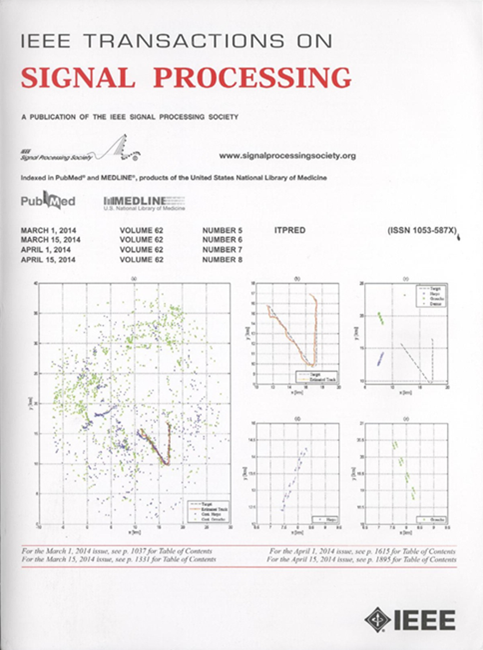最大SINR分布鲁棒自适应波束形成
IF 5.8
2区 工程技术
Q1 ENGINEERING, ELECTRICAL & ELECTRONIC
引用次数: 0
摘要
本文通过在随机干扰加噪声协方差(INC)矩阵和期望信号转向向量的分布不确定性集上实现最坏情况下信噪比(SINR)最大化来解决鲁棒自适应波束形成(RAB)问题。我们的研究探讨了INC矩阵的两个不同的不确定性集和转向向量的三个不确定性集。INC矩阵的不确定性集解释了分布的支持和正半定均值,以及对均值的相似性约束。转向矢量的不确定性集由对其相关概率分布的一阶矩和二阶矩的约束组成。RAB问题被表述为SINR分母在INC矩阵的不确定性集中的任何分布上的最坏情况期望值的最小化,条件是分子的期望值在转向向量的不确定性集中的每个分布大于或等于1。利用线性二次规划的强对偶性,将RAB问题重新表述为二次矩阵不等式问题。随后,通过迭代求解一系列线性矩阵不等式松弛问题来解决这一问题,其中包含了秩一PSD矩阵约束的惩罚项。进一步分析了迭代算法的收敛性。通过仿真实例验证了所提出的鲁棒波束形成方法的有效性,表明该方法在阵列输出信噪比方面的性能得到了改善。本文章由计算机程序翻译,如有差异,请以英文原文为准。
SINR Maximizing Distributionally Robust Adaptive Beamforming
This paper addresses the robust adaptive beamforming (RAB) problem via the worst-case signal-to-interference-plus-noise ratio (SINR) maximization over distributional uncertainty sets for the random interference-plus-noise covariance (INC) matrix and desired signal steering vector. Our study explores two distinct uncertainty sets for the INC matrix and three for the steering vector. The uncertainty sets of the INC matrix account for the support and the positive semidefinite (PSD) mean of the distribution, as well as a similarity constraint on the mean. The uncertainty sets for the steering vector consist of the constraints on the first- and second-order moments of its associated probability distribution. The RAB problem is formulated as the minimization of the worst-case expected value of the SINR denominator over any distribution within the uncertainty set of the INC matrix, subject to the condition that the expected value of the numerator is greater than or equal to one for every distribution within the uncertainty set of the steering vector. By leveraging the strong duality of linear conic programming, this RAB problem is reformulated as a quadratic matrix inequality problem. Subsequently, it is addressed by iteratively solving a sequence of linear matrix inequality relaxation problems, incorporating a penalty term for the rank-one PSD matrix constraint. We further analyze the convergence of the iterative algorithm. The proposed robust beamforming approach is validated through simulation examples, which illustrate improved performance in terms of the array output SINR.
求助全文
通过发布文献求助,成功后即可免费获取论文全文。
去求助
来源期刊

IEEE Transactions on Signal Processing
工程技术-工程:电子与电气
CiteScore
11.20
自引率
9.30%
发文量
310
审稿时长
3.0 months
期刊介绍:
The IEEE Transactions on Signal Processing covers novel theory, algorithms, performance analyses and applications of techniques for the processing, understanding, learning, retrieval, mining, and extraction of information from signals. The term “signal” includes, among others, audio, video, speech, image, communication, geophysical, sonar, radar, medical and musical signals. Examples of topics of interest include, but are not limited to, information processing and the theory and application of filtering, coding, transmitting, estimating, detecting, analyzing, recognizing, synthesizing, recording, and reproducing signals.
 求助内容:
求助内容: 应助结果提醒方式:
应助结果提醒方式:


